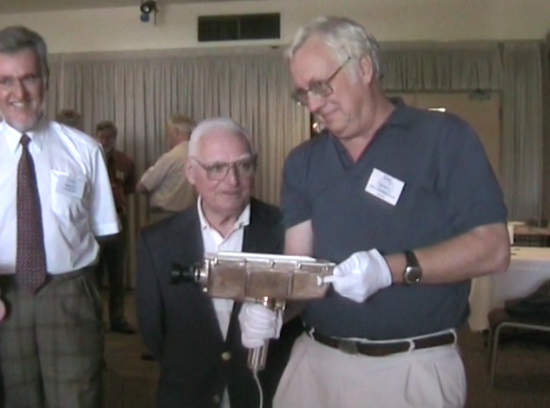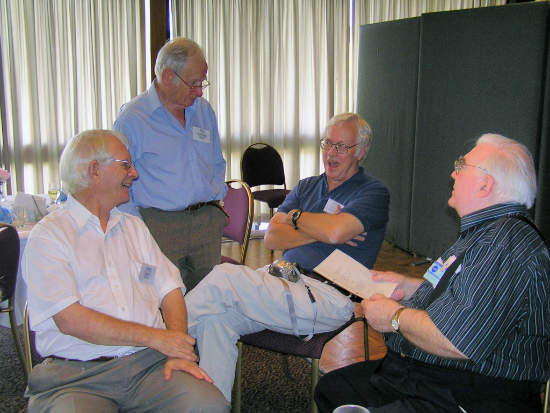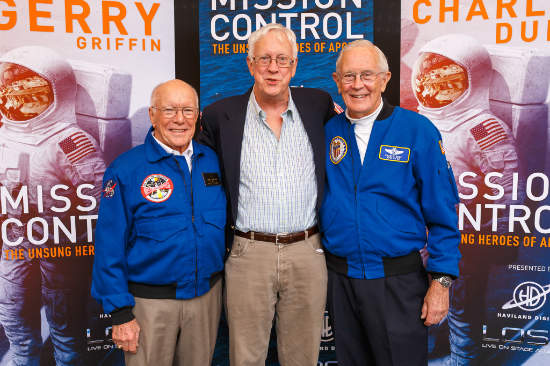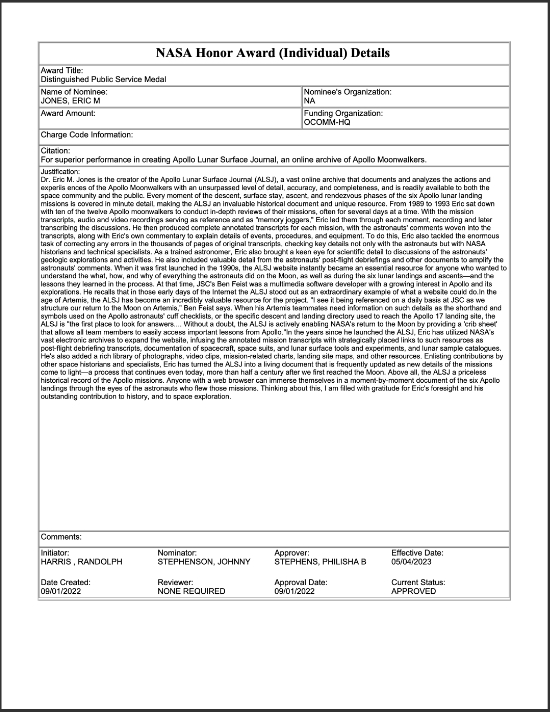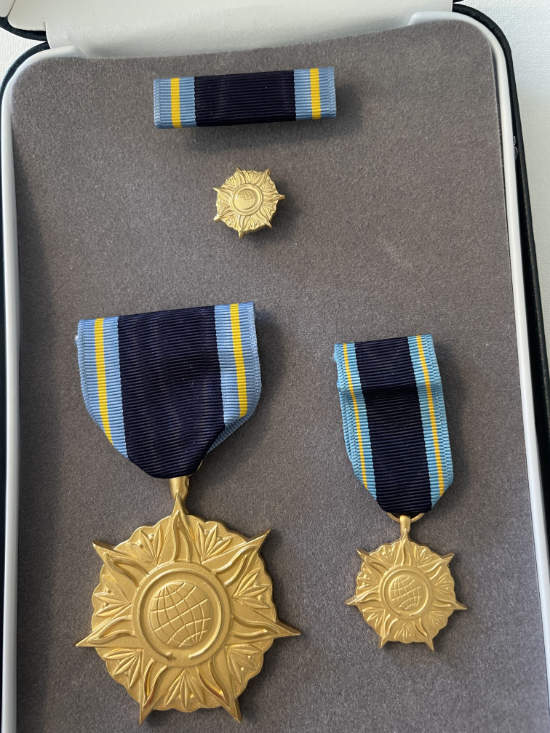Dr. Eric M. Jones
1944 – 2025
Founder of The Apollo Lunar Surface Journal
Di and Eric Jones chat with Apollo 16 Lunar Module Pilot Charlie Duke in Canberra in May 2018. Photo via Mike Dinn. |
Apollo enthusiasts and space historians alike will agree that The Apollo Lunar Surface Journal (ALSJ) is, by far, the most comprehensive and authoritative resource to document the lunar surface activities of the Apollo astronauts from 1969 to 1972.
The ALSJ was the brainchild of Dr. Eric Jones, who conceived the idea in the late 1980s.
Established in the early days of the public Internet, the ALSJ generated much excitement among Apollo enthusiasts, and Dr. Jones attracted a large group of volunteer contributors, though it must be said that the Journal is very much the fruit of Eric’s hard labours.
Over time, the ALSJ birthed a number of companion websites, such as The Apollo Image Gallery, The Apollo Flight Journals, and, more recently, Apollo in Real Time.
So who was Eric Jones?
In response to a request from Journal contributor Frank O’Brien, Eric shared this brief biography –
“I was born in Goldsboro, North Carolina, in 1944 and grew up in the New York suburb of Wantagh, Long Island. I received a B.S. in Astronomy from Caltech in 1966, a Ph.D. in Astronomy from the University of Wisconsin in 1969, and, for the next thirty years, worked at the Los Alamos National Laboratory on a variety of defense-related programs. My main area of expertise was in finite-difference simulations of things like atmospheric fireballs, supernova-remnant evolution, and seismic wave propagation. I worked on the dispersal of ejecta from the Cretaceous-Tertiary impact and served on a National Research Council committee which investigated the question of so-called Nuclear Winter.
In 1983, anthropologist Ben Finney and I organized a meeting called Interstellar Migration and the Human Experience and edited a proceedings of the same title which was published by the University of California. In 1984, I participated in a series of meetings on the feasibility of an early return to the Moon and the development of a lunar science base. Combining my interests in history, anthropology, and space, I began a study of terrestrial analogs to lunar settlement and, in 1986-87, took a year-long sabbatical to read economic history at the University of Melbourne and then the University of Alaska-Anchorage. By the end of the year I concluded that first half century of European settlement in Australia (1788 - 1835) is a pertinent analog because of the high cost of transport from Europe and the reliance of the private sector on import capacity provided by the prison colony. In the lunar case, a science base would play much the same economic role.
In 1988, I visited Houston to learn something about what was involved in getting work done on the Moon. I began reading the Air-to-Ground transcripts and quickly realized that nothing had been done with this amazing resource. During my earlier readings I had become a great fan of a New Zealand historian named J. C. Beaglehole, who had spent most of his long career studying the European exploration of the Pacific and, in particular, producing the definitive editions of Captain Cook’s Journals. It was not hard to imagine the Air-to-Ground transcripts forming the basis of an Apollo Journal.
At this time, Jack Schmitt was an occasional visitor to the Laboratory and, on one of his visits, I got an hour of his time to talk about the difficulty of working in the gloves and other issues. We also talked about my Journal idea and, in April 1989, we spent three days together going through part of Apollo 17 EVA-2. We had a lot of fun and decided that the Journal was worth doing. Jack wrote a letter of introduction to the other astronauts… and the rest is history.”
How did the ALSJ come together – and to be published on the Internet?
It has been a long term effort.
Back in January 2004 Eric wrote, (1)
“The size of the Journal is much like the thickness of the White Cliffs of Dover, which was built up out of shells of (mostly) small sea critters over millions of years. I’ve been assembling the Journal since 1989, working a few hours most days for fifteen years, with tons of input from a great team of volunteers.”
I asked him (also in January 2004) if the Journal began life as a hypertext document. He replied,
“The original idea was to publish the Journal as a four-volume set of books, each of about 800 pages. Spent a lot of time in 1994 trying to interest the major academic houses and got within a gnat’s eyelash of having Oxford do it, but they all decided in the end that the market for such a work was too small for it to be economically viable.
The Web was just starting to hit its stride about the time that Oxford decided on a No Go and friends and Los Alamos convinced me – a decidedly inexperienced techie – that it would be viable on the web. I released portions of Apollo 17 in mid-1995 on a Los Alamos server.”
The decision to publish on the Internet meant that Eric could hyperlink audio and video files, images and reference documents, to the Journal text, making it immensely more useful – and led to the NASA History Office hosting the ever-growing ALSJ.
Eric shared some of the ALSJ story in The Prologue, and in Journal Preparation and Structure. They are both well worth taking the time to read.
Eric’s ability to inspire and include a large team of contributors has been been a major key to the success of the journal.
In more recent times, he handed the running of the ALSJ to Ken Glover in Ottawa, Canada. Eric remained Editor Emeritus until his death.
Ken Glover with Eric at ALSJ Control in 2004. Photo: Angele Glover. |
For the last few decades, Eric lived with his Australian-born wife Di in Albury on the NSW / Victoria border.
Eric and Di Jones and faithful Labrador, “Tilly”, in 2004. |
Eric and Di have joined in a number of Apollo anniversary celebrations in Canberra over the years.
At an Apollo reunion in Canberra on 16 March 2006, Eric stands with Stan Lebar, Manager of the Westinghouse Apollo Lunar Television Camera Program. He is holding the production Slow Scan Apollo TV camera (identical to the one used on Apollo 11) brought to Canberra by Stan for the event. Stuart Wattison is looking on. Screen capture from this video of the event. |
At the same reunion in Canberra, Eric chats with three key players in bringing the Apollo 11 EVA TV to the world. From left: David Cooke, Senior RF Engineer, Parkes Radio Telescope. Ed von Renouard (“Video Von”), who processed the Slow Scan TV from the Moon with the Scan Converter at Honeysuckle Creek during the Apollo 11 EVA. Eric Jones. Mike Dinn, Deputy Director at Honeysuckle Creek 1967-1970. Mike is wearing his badge for admission to the Mission Operations Control Room in Houston during Apollo 17. Photo: John Sarkissian. |
Eric sits with Honeysuckle Creek Video Tech Ed von Renouard who had travelled from London for the same reunion. |
In October 2005, at the IMAX Theatre in Sydney, Eric spoke about the challenges of working on the Moon as the introduction to a preview screening of the film Magnificent Desolation. My daughter, Anne, had offered to print a t-shirt for Eric, and the wording he requested shows his wonderful sense of humour. Eric wore it under his shirt, and, at the end of his presentation, unbuttoned his shirt to display the text, “Apollo was done in a TV studio … Yeah, right!” Later, the above photo of Anne and Eric, taken just after the event, was picked up by a German author and used on the cover of his “Apollo was a hoax” book. Some people just don’t get jokes. – Colin M. |
Eric with Flight Director Gerry Griffin (left) and Astronaut Charlie Duke in Canberra, May 2018. |
NASA Distinguished Public Service Medal
On 3rd May 2023, Eric was the recipient of the NASA Distinguished Public Service Medal in recognition of his enormous contribution to Apollo history.
While Eric was unable to be at the Marshall Space Flight Center in Huntsville, Alabama, for the presentation, many around the world continue to be profoundly grateful for his work and will be glad to know of this award.
Apollo historian and author Andrew Chaikin nominated Eric and wrote the Justification below.
Click for a PDF file of the NASA document outlining the justification for Eric’s award. Or see below for a formatted version of the text. |
Eric’s medal. Photo with thanks to Eric and Di Jones. |
Distinguished Public Service Medal For superior performance in creating Apollo Lunar Surface Journal, an online archive of Apollo Moonwalkers. Justification: Dr. Eric M. Jones is the creator of the Apollo Lunar Surface Journal (ALSJ), a vast online archive that documents and analyzes the actions and experiences of the Apollo Moonwalkers with an unsurpassed level of detail, accuracy, and completeness, and is readily available to both the space community and the public. Every moment of the descent, surface stay, ascent, and rendezvous phases of the six Apollo lunar landing missions is covered in minute detail, making the ALSJ an invaluable historical document and unique resource. From 1989 to 1993 Eric sat down with ten of the twelve Apollo moonwalkers to conduct in-depth reviews of their missions, often for several days at a time. With the mission transcripts, audio and video recordings serving as reference and as “memory joggers,” Eric led them through each moment, recording and later transcribing the discussions. He then produced complete annotated transcripts for each mission, with the astronauts’ comments woven into the transcripts, along with Eric’s own commentary to explain details of events, procedures, and equipment. To do this, Eric also tackled the enormous task of correcting any errors in the thousands of pages of original transcripts, checking key details not only with the astronauts but with NASA historians and technical specialists. As a trained astronomer, Eric also brought a keen eye for scientific detail to discussions of the astronauts’ geologic explorations and activities. He also included valuable detail from the astronauts’ post-flight debriefings and other documents to amplify the astronauts’ comments. When it was first launched in the 1990s, the ALSJ website instantly became an essential resource for anyone who wanted to understand the what, how, and why of everything the astronauts did on the Moon, as well as during the six lunar landings and ascents—and the lessons they learned in the process. At that time, JSC’s Ben Feist was a multimedia software developer with a growing interest in Apollo and its explorations. He recalls that in those early days of the Internet the ALSJ stood out as an extraordinary example of what a website could do. In the age of Artemis, the ALSJ has become an incredibly valuable resource for the project. “I see it being referenced on a daily basis at JSC as we structure our return to the Moon on Artemis,” Ben Feist says. When his Artemis teammates need information on such details as the shorthand and symbols used on the Apollo astronauts’ cuff checklists, or the specific descent and landing directory used to reach the Apollo 17 landing site, the ALSJ is “the first place to look for answers. … Without a doubt, the ALSJ is actively enabling NASA's return to the Moon by providing a ‘crib sheet’ that allows all team members to easily access important lessons from Apollo.” In the years since he launched the ALSJ, Eric has utilized NASA’s vast electronic archives to expand the website, infusing the annotated mission transcripts with strategically placed links to such resources as post-flight debriefing transcripts, documentation of spacecraft, space suits, and lunar surface tools and experiments, and lunar sample catalogues. He’s also added a rich library of photographs, video clips, mission-related charts, landing site maps, and other resources. Enlisting contributions by other space historians and specialists, Eric has turned the ALSJ into a living document that is frequently updated as new details of the missions come to light—a process that continues even today, more than half a century after we first reached the Moon. Above all, the ALSJ a priceless historical record of the Apollo missions. Anyone with a web browser can immerse themselves in a moment-by-moment document of the six Apollo landings through the eyes of the astronauts who flew those missions. Thinking about this, I am filled with gratitude for Eric’s foresight and his outstanding contribution to history, and to space exploration. |
The American Astronautical Society’s Ordway Award
In 2024, Eric was honoured with The American Astronautical Society’s Ordway Award. (The Ordway Award is named in memory of Frederick I. Ordway III, human spaceflight advocate and chronicler of the history of rocketry and space travel.)
According to the AAS website,
“Eric Jones is recognized for the Apollo Lunar Surface Journal, an exceptional, comprehensive, and accessible online multimedia resource for detailed study of the first human explorations of the Moon.”
(Thanks to Andrew Chaikin for news of this award.)
Asteroid named in honour of Eric
Asteroid 14544 Ericjones (1997 SG21) is named for Eric. It is a 9.8km wide main-belt asteroid, orbiting the Sun every 5.34 years. The naming was instigated by ALSJ Contributor Professor Ulli Lotzmann.
Interviews
The late Peter Aylward of the Space Association of Australia interviewed Eric several times for The Space Show broadcast on Southern FM in Melbourne. Here is one of those interviews: (mp3 files, might download to your device.) |
In March 2004, for Eric’s 60th birthday, a number of his friends, members of the “ALSJ – AFJ Nailsoup Group” organised for Eric to receive an inscribed copy of David Levy’s biography of Gene Shoemaker, Shoemaker by Levy, the Man Who Made an Impact. Accompanying the book was a signed letter which included these words:
|
– Colin Mackellar.
References:
1. e-mail from Eric to Colin Mackellar, 21 January 2004.



